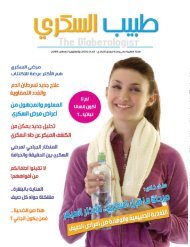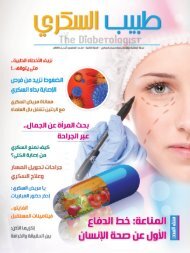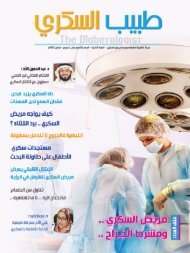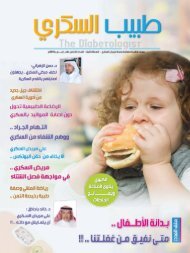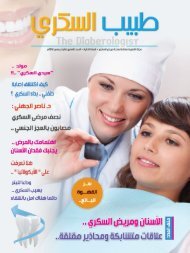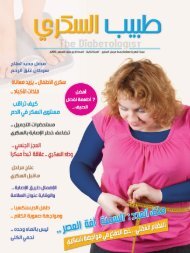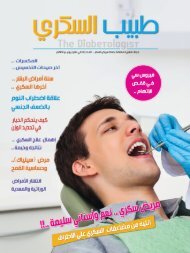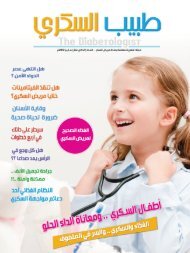The Diabetologist #21
طبيب السكري - العدد 21
طبيب السكري - العدد 21
You also want an ePaper? Increase the reach of your titles
YUMPU automatically turns print PDFs into web optimized ePapers that Google loves.
million people have T2D and more than 7 million of<br />
them are unaware of their diagnosis. Characterized<br />
by obesity, insulin resistance, dyslipidemia, hypertension,<br />
microvascular and macrovascular complications,<br />
and a predisposition in African Americans,<br />
Hispanics, and Native Americans, T2D indirectly<br />
accounts for nearly 1 in every 10 health care dollars.14<br />
Given the tremendous burden T2D places<br />
on the U.S. health care system, it is not surprising<br />
that patients, health care providers, and researchers<br />
often use the nonspecific termdiabetes when<br />
referring to T2D. However, the practice of referring<br />
to T2D as simply diabetes cultivates numerous<br />
dangerous misconceptions regarding the etiology,<br />
pathophysiology, and treatment of other subtypes<br />
of diabetes.<br />
In addition to T1D and T2D, a growing number<br />
of Americans are diagnosed with diabetes during<br />
pregnancy. Gestational diabetes mellitus<br />
(GDM) currently affects ~7% of pregnancies<br />
(200,000 cases annually) with<br />
5–10% of affected women diagnosed<br />
with T2D after delivery<br />
(and some are diagnosed with<br />
auto-immune T1D, as well).15<br />
(See chapter 17 for more<br />
details.) Even for those who<br />
return to normal postpartum<br />
glucose metabolism, the 20-<br />
year risk of developing T2D<br />
approaches 60% once GDM<br />
has been diagnosed. Notably,<br />
the screening and diagnostic<br />
criteria for GDM are unique<br />
from other forms of diabetes.<br />
Cystic fibrosis–related diabetes<br />
(CFRD) is another subtype of diabetes<br />
requiring a unique therapeutic approach.<br />
Named for the characteristic cyst and<br />
fibrosis formation noted in the exocrine pancreas<br />
of affected patients, cystic fibrosis (CF) is an autosomal<br />
recessive disorder caused by a mutation<br />
in a chloride transporter known as the cystic fibrosis<br />
transmembrane conductance regulator. While<br />
the primary complication in CF is chronic pulmonary<br />
disease, up to 75% of adults with CF develop<br />
glucose intolerance and nearly 15% have CFRD.<br />
CFRD is unique in that it shares some pathophysiology<br />
with both T1D and T2D. Namely, patients<br />
with CFRD have a combination of 1) reduced β-cell<br />
mass (a feature typically associated with T1D) secondary<br />
to the chronic pancreatic inflammation and<br />
2) severe insulin resistance (a feature associated<br />
with T2D) as a result of chronic and often subclinical<br />
pulmonary infections. Given the unique hypermetabolic<br />
state associated with CF, patients with<br />
CFRD require high-calorie diets and tight glycemic<br />
control to avoid a catabolic state. As such, current<br />
CFRD guidelines discourage the use of oral<br />
hypoglycemics or calorie restriction and focus<br />
instead on the use of insulin to manage glucose<br />
abnormalities.16<br />
Finally, clinicians should be aware of the monogenic<br />
forms of diabetes. Accounting for only 1–5%<br />
of all diabetes cases, monogenic diabetes results<br />
from single gene mutations that are inherited in an<br />
autosomal dominant fashion. <strong>The</strong>se mutations do<br />
not result in insulin resistance or autoimmunity but<br />
instead induce diabetes by blunting the capacity<br />
of otherwise normal β-cells to release insulin. <strong>The</strong><br />
two main forms of monogenic diabetes are neonatal<br />
diabetes mellitus (NDM) and maturity-onset<br />
diabetes of the young (MODY). NDM is a rare<br />
condition and occurs in 1/100,000 to<br />
1/500,000 newborns and is often<br />
mistaken for T1D due to its association<br />
with ketoacidosis and its<br />
requirement for insulin therapy.<br />
However, T1D is exceedingly<br />
rare before 6 months of age<br />
and any child diagnosed<br />
with T1D before 9 months of<br />
age should be screened for<br />
monogenic diabetes. <strong>The</strong>re<br />
are two forms of NDM, transient<br />
NDM, which resolves<br />
within weeks to months, and<br />
permanent NDM, which is<br />
associated with a lifelong dependence<br />
on insulin. Testing for<br />
known diagnostic mutations allows<br />
accurate differentiation of the two subtypes<br />
of NDM and emphasizes the need for<br />
clinicians to be aware of rare forms of diabetes. In<br />
contrast to NDM, MODY is a mild form of diabetes<br />
that is commonly, but not always, diagnosed<br />
in adulthood. Patients initially diagnosed with T1D<br />
who fail to demonstrate autoantibody positivity or<br />
who persist with near normal glycemic control on<br />
minimal insulin should be screened for MODY. Diagnosis<br />
of MODY is especially important as some<br />
forms of MODY may be controlled with oral hypoglycemic<br />
agents. For a subset of patients, the<br />
appropriate diagnosis can mean the difference<br />
between a lifetime of insulin injections or effective<br />
glycemic control with a sulfonylurea.17<br />
issue 21 < May 2013<br />
03






